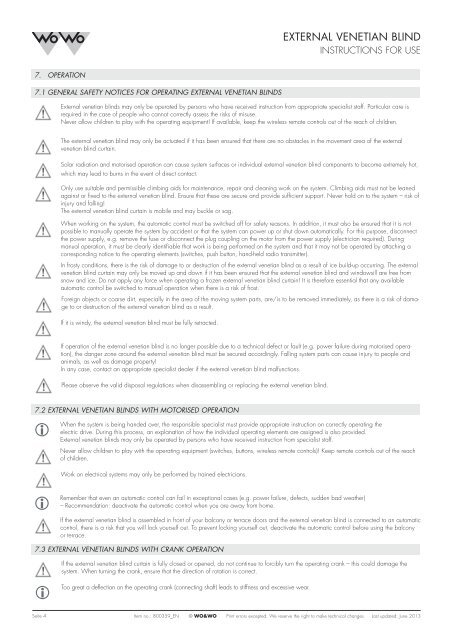EXTERNAL VENETIAN BLIND - Wo&Wo;
EXTERNAL VENETIAN BLIND - Wo&Wo;
EXTERNAL VENETIAN BLIND - Wo&Wo;
You also want an ePaper? Increase the reach of your titles
YUMPU automatically turns print PDFs into web optimized ePapers that Google loves.
<strong>EXTERNAL</strong> <strong>VENETIAN</strong> <strong>BLIND</strong><br />
INSTRUCTIONS FOR USE<br />
7. OPERATION<br />
7.1 GENERAL SAFETY NOTICES FOR OPERATING <strong>EXTERNAL</strong> <strong>VENETIAN</strong> <strong>BLIND</strong>S<br />
External venetian blinds may only be operated by persons who have received instruction from appropriate specialist staff. Particular care is<br />
required in the case of people who cannot correctly assess the risks of misuse.<br />
Never allow children to play with the operating equipment! If available, keep the wireless remote controls out of the reach of children.<br />
The external venetian blind may only be actuated if it has been ensured that there are no obstacles in the movement area of the external<br />
venetian blind curtain.<br />
Solar radiation and motorised operation can cause system surfaces or individual external venetian blind components to become extremely hot,<br />
which may lead to burns in the event of direct contact.<br />
Only use suitable and permissible climbing aids for maintenance, repair and cleaning work on the system. Climbing aids must not be leaned<br />
against or fixed to the external venetian blind. Ensure that these are secure and provide sufficient support. Never hold on to the system – risk of<br />
injury and falling!<br />
The external venetian blind curtain is mobile and may buckle or sag.<br />
When working on the system, the automatic control must be switched off for safety reasons. In addition, it must also be ensured that it is not<br />
possible to manually operate the system by accident or that the system can power up or shut down automatically. For this purpose, disconnect<br />
the power supply, e.g. remove the fuse or disconnect the plug coupling on the motor from the power supply (electrician required). During<br />
manual operation, it must be clearly identifiable that work is being performed on the system and that it may not be operated by attaching a<br />
corresponding notice to the operating elements (switches, push button, hand-held radio transmitter).<br />
In frosty conditions, there is the risk of damage to or destruction of the external venetian blind as a result of ice build-up occurring. The external<br />
venetian blind curtain may only be moved up and down if it has been ensured that the external venetian blind and windowsill are free from<br />
snow and ice. Do not apply any force when operating a frozen external venetian blind curtain! It is therefore essential that any available<br />
automatic control be switched to manual operation when there is a risk of frost.<br />
Foreign objects or coarse dirt, especially in the area of the moving system parts, are/is to be removed immediately, as there is a risk of damage<br />
to or destruction of the external venetian blind as a result.<br />
If it is windy, the external venetian blind must be fully retracted.<br />
If operation of the external venetian blind is no longer possible due to a technical defect or fault (e.g. power failure during motorised operation),<br />
the danger zone around the external venetian blind must be secured accordingly. Falling system parts can cause injury to people and<br />
animals, as well as damage property!<br />
In any case, contact an appropriate specialist dealer if the external venetian blind malfunctions.<br />
Please observe the valid disposal regulations when disassembling or replacing the external venetian blind.<br />
7.2 <strong>EXTERNAL</strong> <strong>VENETIAN</strong> <strong>BLIND</strong>S WITH MOTORISED OPERATION<br />
When the system is being handed over, the responsible specialist must provide appropriate instruction on correctly operating the<br />
electric drive. During this process, an explanation of how the individual operating elements are assigned is also provided.<br />
External venetian blinds may only be operated by persons who have received instruction from specialist staff.<br />
Never allow children to play with the operating equipment (switches, buttons, wireless remote controls)! Keep remote controls out of the reach<br />
of children.<br />
<strong>Wo</strong>rk on electrical systems may only be performed by trained electricians.<br />
Remember that even an automatic control can fail in exceptional cases (e.g. power failure, defects, sudden bad weather)<br />
– Recommendation: deactivate the automatic control when you are away from home.<br />
If the external venetian blind is assembled in front of your balcony or terrace doors and the external venetian blind is connected to an automatic<br />
control, there is a risk that you will lock yourself out. To prevent locking yourself out, deactivate the automatic control before using the balcony<br />
or terrace.<br />
7.3 <strong>EXTERNAL</strong> <strong>VENETIAN</strong> <strong>BLIND</strong>S WITH CRANK OPERATION<br />
If the external venetian blind curtain is fully closed or opened, do not continue to forcibly turn the operating crank – this could damage the<br />
system. When turning the crank, ensure that the direction of rotation is correct.<br />
Too great a deflection on the operating crank (connecting shaft) leads to stiffness and excessive wear.<br />
Seite 4<br />
Item no.: 800359_EN © WO&WO Print errors excepted. We reserve the right to make technical changes. Last updated: June 2013
















